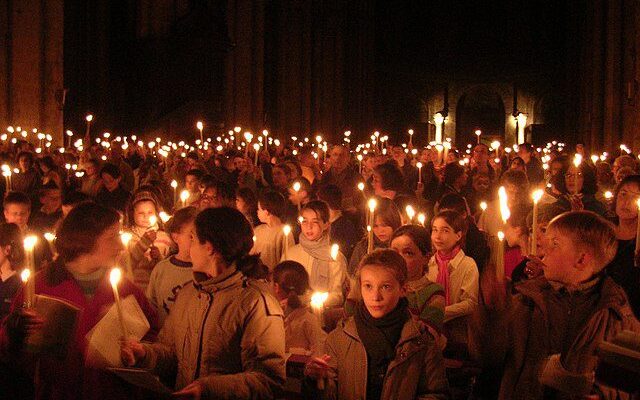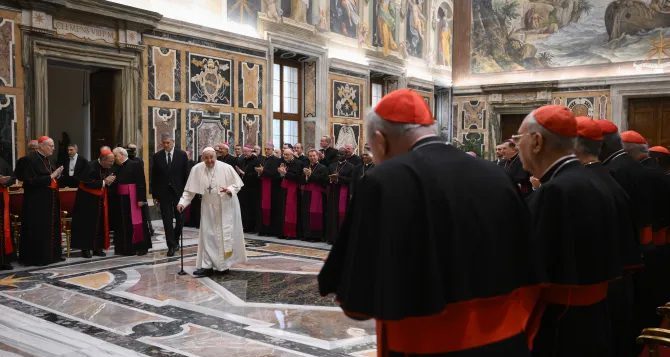A: “The Deacon places the paschal candle on a large candlestand…[a]nd lights are lit throughout the church, except for the altar candles.”1 The directive is clear and requires much contortion to believe it means something else. Liturgist Father Paul Turner calls it “probably the most ignored rubric in Holy Week.”2 The timing of turning on the lights in the church at the Easter Vigil seems to vary across parishes and dioceses and is subjective based on one’s understanding of symbolism. In this reply, we will explore the theology of light and darkness and the rubrics over the past decades. Then, we will look at the Easter Vigil liturgy texts to understand the wisdom of the rubric.
Throughout Scripture, there are references to light and darkness. We will focus particularly on their meaning in creation, the incarnation, and the Paschal Mystery.
Creation: Before the world was created, there was darkness. This darkness is described as “chaos” or “without form or shape” (Genesis 1:2). Through creation, God created light and made a definite demarcation: “God then separated the light from the darkness. God called the light ‘day,’ and the darkness he called ‘night’” (Genesis 1:4-5).
Even though there is day and night, St. John tells us: “God is light, and in him there is no darkness at all” (1 John 5). In his article for last month’s AB Insight (“Shedding Light on Candlemas”), Donald DeMarco stated, “‘Light and dark,’ as St. Paul has remarked, “have nothing in common.” They oppose each other in a most fundamental way.”3 Light throughout Scripture is associated with “God’s radiant splendor.”4 Darkness is not an opposing force equal to God (a form of the heresy of dualism or Manichaeism). Instead, darkness or evil can be thought of as “a corruption of something originally good or as the absence of some good that ought to be present.”5
As during the Exodus, God does not abandon us during the night. He led the Israelites during the day by a “column of cloud”; at night, a “column of fire [gave] them light” (Exodus 13:21). The Paschal Candle is a symbol of this “column of fire.” We expressly recall this event in the Exsultet: “This is the night that with a pillar of fire banished the darkness of sin.”6
The writer of Ecclesiastes compares light and dark with the wise man and fool; however, he states death comes to both (Ecclesiastes 2:13-14). But the incarnation will change this leveling power of death.
Incarnation: “The people who walked in darkness have seen a great light; upon those who dwelt in the land of gloom a light has shone” (Isaiah 9:1). This Christmas reading from the Mass During the Night foretells Jesus as the “light of the world” (John 8:12). If God is the source of all truth, then Jesus Christ, who is “God from God, Light from Light,” is the truth (John 1:14; 8:12).
Pope Francis states, “In the absence of light everything becomes confused; it is impossible to tell good from evil, or the road to our destination from other roads which take us in endless circles, going nowhere.”7 St. Paul states that light represents “all that is good and right and true” (Ephesians 5:9). Therefore, exposing the “unfruitful works of darkness” to the light makes them visible; the hope is that this exposure of the darkness leads to repentance and conversion (Ephesians 5:13).
Christ became flesh to us to believe in him. In his final days, he encouraged the crowd to “[w]alk while you have the light, so that darkness may not overcome you; …believe in the light, so that you may become children of the light” (John 12:35-36).
Paschal Mystery: “At noon darkness came over the whole land until three in the afternoon” (Mark 15:33). The light and darkness analogy continues in Christ’s death and resurrection. The darkness during Christ’s three hours on the cross, foreshadowed a few chapters earlier, is a sign of an impending judgment. St. Hippolytus describes the Paschal Mystery—Christ’s death and resurrection—as follows: “Life extends over all beings and fills them with unlimited light; …the great Christ shines over all beings more brightly than the sun. Therefore a day of long, eternal light is ushered in for us who believe in him, a day which is never blotted out.”8
In a similar way, St. Cyril of Jerusalem describes Baptism as “immersed in the water it was like night for you and you could not see, but when you rose again it was like coming into broad daylight.”9 In Baptism, we are “bathed in the light,” receive the light of Christ, and are called to live as “children of the light.”10
Rubrics and Other Directives
Father Turner comments about situations where the church building remains in darkness during the Exsultet, and even during the Scripture readings: “But the rubrics envision something else.”11 For those who might think the rubric is new to the third edition of the Missal implemented in 2011, in fact, it has been the instruction for over 50 years. The rubric from the 1975 and 1985 sacramentaries is present in the same location (after the third “Light of Christ” dialogue) as that of the 2011 Sacramentary. In each case, the rubric states: “Then the lights in the church are put on.” The 1966 Sacramentary states, after the third dialogue, “The candles of the people are lighted from the blessed candle, and the lights of the church are lighted.”
A statement in the 1988 Circular Letter Concerning Preparation and Celebration of Easter Feasts says, “The light from the paschal candle should be gradually passed to the candles that all present are holding in their hands; the electric lighting should be switched off.”12 This is not inconsistent with the rubrics: the phrase “should be switched off” does not mean it occurs at that point. And the rubrics since 1975 envision that the lights within the church are off during the passing of the light and procession with the Paschal Candle.
Easter Vigil Procession
The first part of the Easter Vigil “consists of symbolic acts and gestures, which require that they be performed in all their fullness and nobility, so that their meaning, as explained by the introductory words of the celebrant and the liturgical prayers, may be truly understood by the faithful.”13 “In all our efforts on behalf of the liturgy, the determining factor must always be our looking to God. We stand before God—he speaks to us and we speak to him. Whenever in our thinking we are only concerned about making the liturgy attractive, interesting and beautiful, the battle is already lost.”14
Every liturgy relies on the union of words, actions, imagery, and symbolism—a “means
of perceptible signs by which the faith is nourished, strengthened, and expressed.”15 Well-celebrated liturgy requires a congruence of all these elements. Together, they must move in the same direction to achieve the same goal.
Before the procession into the Church, the priest, as he lights the Paschal Candle, exclaims: “May the light of Christ rising in glory dispel the darkness of our hearts and minds.”16 These words foreshadow those in the Exsultet which speak of the radiance of Christ’s light banishing the darkness.
During the procession from the fire to the front of the Church, the amount of light increases with each proclamation of “The Light of Christ.” After the first proclamation, the priest lights his candle. After the second, all the people’s candles are lit. At the third, all the people are in the church with their lit candles.
The Exsultet
The United States Conference of Catholic Bishops notes a progression from the beginning of the Easter Vigil: a “symbolic movement has been from darkness to light.”17 With the Exsultet, “words and music are used to praise and thank God for what the light represents: God’s saving activity throughout human history, culminating in Christ’s defeat of death and resurrection from the dead.”18
Throughout the Exsultet, we hear verses calling out for the church to be fully lit (emphasis added):
- “Be glad, let earth be glad, as glory floods her, ablaze with light from her eternal King, let all corners of the earth be glad, knowing an end to gloom and darkness.”
- “This is the night that with a pillar of fire banished the darkness of sin.”
- “The night shall be as bright as day.”
- “The sanctifying power of this night dispels wickedness, washes faults, away, restores innocence to the fallen, and joy to mourners, drives out hatred, fosters concord, and brings down the mighty.”
- “But now we know the praises of this pillar, which glowing fire ignites for God’s honor, a fire into many flames divided, yet never dimmed by sharing of its light.”
- “This candle, hallowed to the honor of your name, may persevere undimmed to overcome the darkness of this night.”
- “May this flame be found still burning by the Morning Star: the one Morning Star who never sets, Christ your Son.”
As seen above, having the church lights off during the Exsultet while proclaiming Christ’s radiant light is inconsistent. Likewise, sitting in darkness or semi-darkness during the Liturgy of the Word is incompatible with proclaiming Sacred Scripture.
The rubric for turning on the lights before the Exsultet matches the words and what we see, helping us understand Christ’s eternal and irresistible power over darkness.
Image Source: AB/Wikimedia Commons
Footnotes
- Roman Missal, Easter Vigil in the Night ¶ 17 (emphasis added).
- Paul Turner, Glory in the Cross (Liturgical Press: Collegeville, 2011), 127.
- https://adoremus.org/2024/01/shedding-light-on-candlemas/
- Martin and Wright, The Gospel of John (Catholic Commentary on Sacred Scripture, 2015), 34.
- Martin and Wright, The Gospel of John (Catholic Commentary on Sacred Scripture, 2015), 34.
- Roman Missal, Easter Vigil in the Night ¶19 (Exsultet)(Lines 42-44).
- Pope Francis, Lumen Fidei (2013), 3.
- CCC 1165.
- Jerusalem Catecheses (Cat. 21, Mystagogica 3, 1-3: PG 33, 1087-1091).
- Rite of Baptism, 47 and 64.
- https://thepriest.com/2022/03/15/this-is-the-night/
- 1988 Circular Letter Concerning Preparation and Celebration of Easter Feasts, 83.
- 1988 Circular, 82.
- Pope Benedict XVI, Visit to Heiligenkreuz Abbey (September 9, 2007)
- General Instruction to the Roman Missal ¶ 20.
- Roman Missal, EV 14.
- https://www.usccb.org/prayer-and-worship/liturgical-year-and-calendar/easter/commentary-on-easter-proclamation-exsultet
- https://www.usccb.org/prayer-and-worship/liturgical-year-and-calendar/easter/commentary-on-easter-proclamation-exsultet


